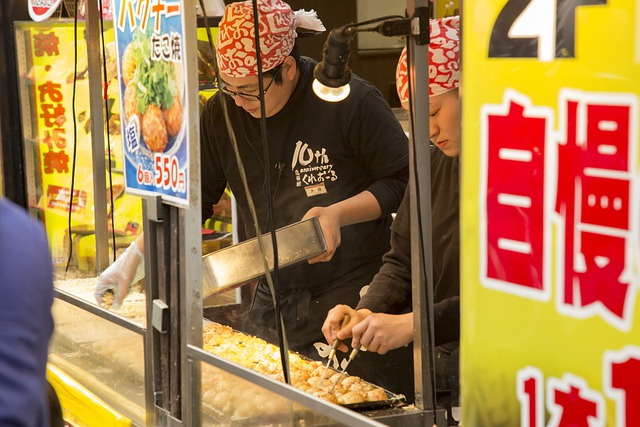Japan is well known for its culinary delights. From sushi to ramen, Japanese food has made its way into the cultural mainstream across the world. However, its most popular exports are just the tip of Japan’s gastronomical iceberg.
There are loads more Japanese dishes and the street-food available throughout Tokyo is a fantastic place to start. In this post, I’ll take you on a Tokyo street food tour, and give you an introduction to some of the best treats to enjoy as you explore the city.
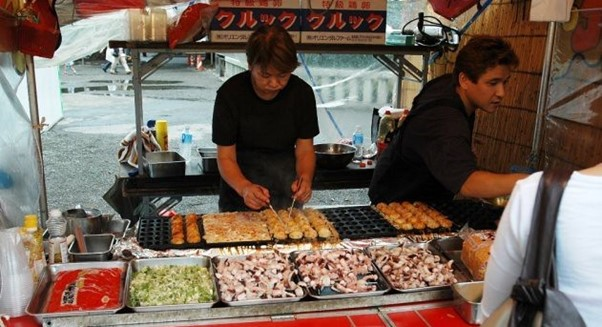
A Tokyo Street Food Tour: What To Know Before You Go
Japan has a culture that is deeply entrenched with a system of etiquette and politeness. One aspect of this that you might not be aware of is that it can be considered rude to eat whilst walking along.
It’s the sort of thing that younger folks are unlikely to care about but, if you want to avoid some disapproving side-eyes from the older generations, consider taking a pause to enjoy your food.
Another point to remember is that you will rarely find any public bins around Tokyo. It is generally expected that any trash you accumulate through the day will be taken home and disposed of there.
If you don’t want to be stuck with food wrappers and dirty napkins stuffed in your bag all day, then it actually works in your favour to stop and eat near the food stalls, so you’ll have somewhere to leave your rubbish.
Japan is also a country strongly in tune with the seasons. The food and snacks available, both from street vendors and in stores, can vary month to month.
The most popular items are increasingly available year-round, but some flavour variants, such as Sakura, are still largely tied to their respective seasons.
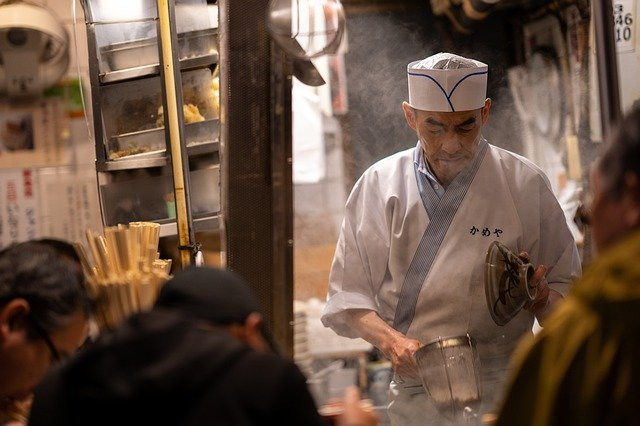
10 Tokyo Street Food Dishes You Have To Try
As you travel around the city, you will discover that there are endless varieties and innovations of Tokyo street food available to try.
I have selected just ten of the best or most iconic items for you to keep an eye out for as you explore the city and begin your Tokyo street food tour.
Takoyaki
When I think of Tokyo street food, or Japanese street food in general, Takoyaki is, without fail, the first thing to spring to mind.
The bite sized pieces of octopus, green onion, and ginger, encased in batter, are perfect for munching as you take in the sights and attractions. Topped with Takoyaki sauce, mayonnaise, shredded seaweed, and bonito flakes, every mouthful is bursting with flavour.
Typically served in a boat-shaped, bamboo bowl and eaten with tiny wooden skewers, Takoyaki is perfectly designed for delicious convenience.
You won’t struggle to find it either. No festival, food market, or big tourist attraction is complete without a Takoyaki stand somewhere in the vicinity.
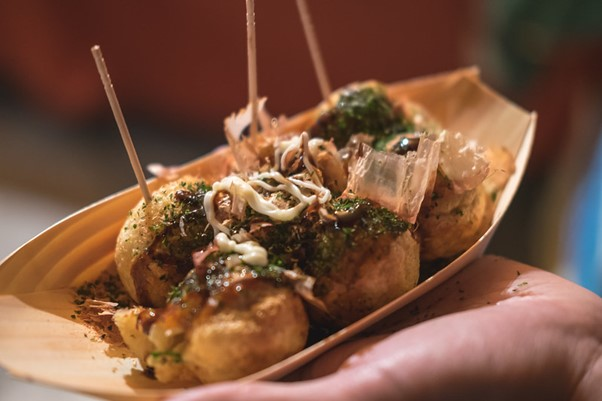
Okonomiyaki
Literally translating as “whatever you like, fried”, okonomiyaki is one of the most customisable dishes you could ask for.
Often referred to as a Japanese pancake, the base of an okonomiyaki consists of shredded cabbage and pancake batter, fried together with meat, seafood, or almost any filling you want.
Once the pancake is cooked, it is topped with mayonnaise, powdered seaweed, bonito flakes, and a special okonomiyaki sauce. The sweet, salty, umami flavours of the sauce are what really bring the whole dish together.
The standard style of okonomiyaki originated in Osaka. However, a popular variation developed in Hiroshima that includes the addition of soba noodles into the batter. Hiroshima okonomiyaki also often adds a fried egg on top.
Both styles are delicious and readily available around Tokyo. Fierce debate rages over which style is superior. You should definitely try both in order to decide which variety is best for yourself.

Steamed Buns
Fluffy, filling, and easy to eat without making a mess, steamed buns make the perfect quick meal to tide you over whilst sightseeing. Consisting of soft, airy dough, stuffed with juicy fillings, steamed buns are the epitome of a comfort food.
The most traditional filling is pork mince, but most vendors will sell a variety of options. Curry is a popular alternative, and you won’t struggle for vegetarian choices either. You can even find sweet options, stuffed with red bean paste.
They may seem small at first glance, but the moist, pillowy dough makes them more substantial than they look.
It will be tempting to order several at once to try all the flavours. However, take my advice and start with just one or two at a time. You can always go back for more later.
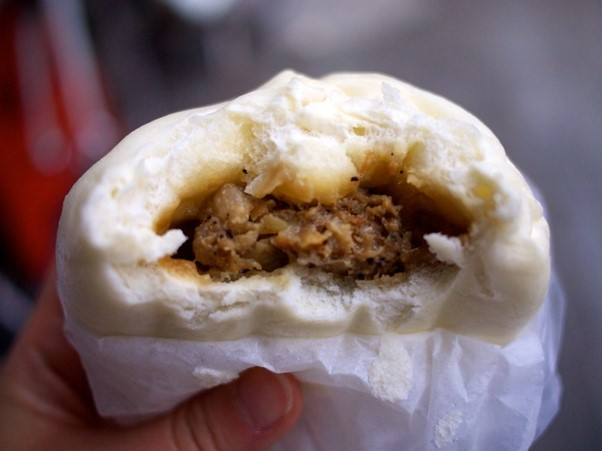
Yakitori
Yakitori is one of those relatively simple dishes that is nonetheless ubiquitous with Japanese casual cuisine. Along with being a hugely popular bar snack, you would be hard pressed to find a food market or festival without a yakitori stand.
Yakitori literally means ‘grilled bird’, which is usually chicken. The meat is skewered and grilled over charcoal, lending it a delicious smoky flavour. It is then brushed with a sticky, yakitori sauce and sometimes sprinkled with sesame seeds and chopped green onions.
There are various types of yakitori available from most vendors. You can choose which part of the chicken you prefer, such as thigh or even liver.
If getting your five a day is important, then opt for negima yakitori, which includes a wedge of spring onion between each chunk of meat.
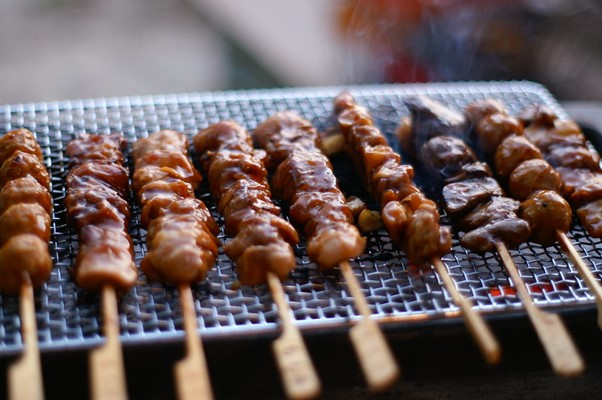
Roasted Sweet Potato (Yaki-Imo)
Ah, the humble sweet potato. Probably not the first thing most westerners would think of when considering Japanese cuisine or Tokyo street food. However, roasted sweet potatoes, or yaki-imo, as they are often called, are a staple on the Tokyo streets come autumn.
Sweet potato is a popular flavour in Japan, used in everything from lattes to chocolate and ice-cream.
The ultimate comfort food when the weather turns cold is a whole roasted sweet-potato, hot off a wood burning stove. The crispy skin and fluffy, flavoursome insides make the perfect filling snack.
You are sure to find a sweet potato vendor at any festival or just set up on a busy street corner. Keep an eye for the tiny trucks that meander through the streets looking for hungry customers too.
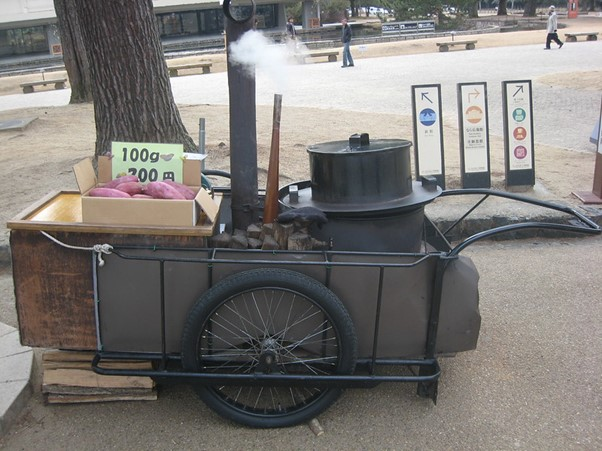
Dango
As far as Japanese sweets go, dango is one of the most iconic. Little dumplings made of sweetened rice flour are skewered and then served either plain, grilled, or with a variety of sauces and toppings.
The dumplings have a distinct, chewy texture, unlike anything you might be used to in the west.
One of the most popular varieties is mitarashi dango. This semi-sweet variety is grilled and then glazed with a thick syrup of sweetened soy sauce. It’s especially perfect for those with less of a sweet tooth.
In the spring, particularly around cherry blossom season, hanami dango is the go to. Hanami means ‘flower viewing’, so this variety is traditionally enjoyed whilst observing the blooming sakura trees.
Hanami dango consists of three dumplings, one plain, one coloured green and flavoured with matcha, and one coloured pink and flavoured with strawberry powder.
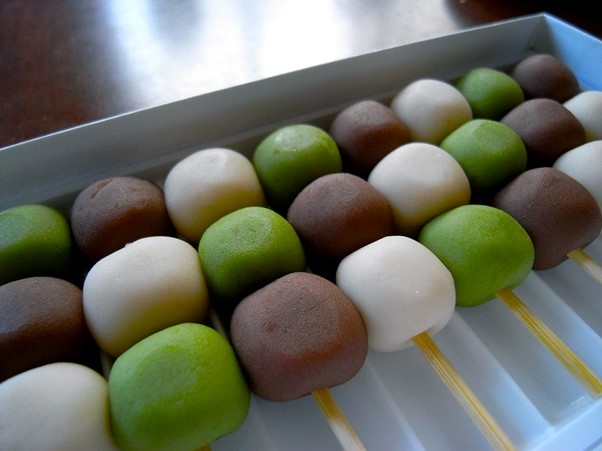
Taiyaki
Taiyaki are sweet, fish shaped pastries and one of the most recognisable Japanese desserts. They are shaped like a sea bream, a symbol of good luck.
Formed from a batter similar to that of a pancake, taiyaki are grilled on moulded griddles, producing a crispy outer layer and a fluffy centre.
Traditionally, taiyaki are filled with a sweet red bean paste found in many Japanese desserts. This is my personal favourite, but nowadays most vendors will sell taiyaki in a variety of flavours. Custard, chocolate, and matcha cream are some of the most popular alternatives.
You can even find some savoury options, such as Japanese curry, but they are much less common.
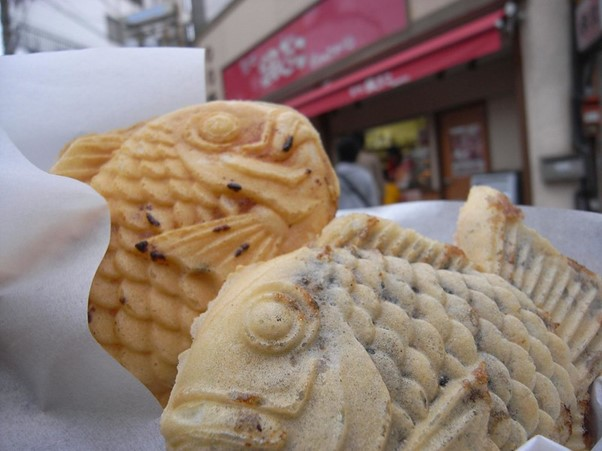
Shaved Ice (Kakigori)
Few treats are as synonymous with Japanese summers as kakigori, or shaved ice. In a country notorious for its sweltering summer months, it’s unsurprising that a refreshing treat of flavoured ice has become so popular.
The standard form of kakigori boasts piles of plain shaved ice, doused in colourful flavoured syrups. Of course, increasingly decadent and complex forms of the dessert are also available.
Some stalls offer a variety of toppings or even more indulgent bases of frozen condensed milk or green tea.
Kakigori is a staple at summer festivals, but it is also popular enough to find in dessert shops year-round. Aside from being refreshing, it is also a delightfully light dessert, so is perfect for when you’ve already spent the day indulging in Tokyo’s many Japanese delicacies.
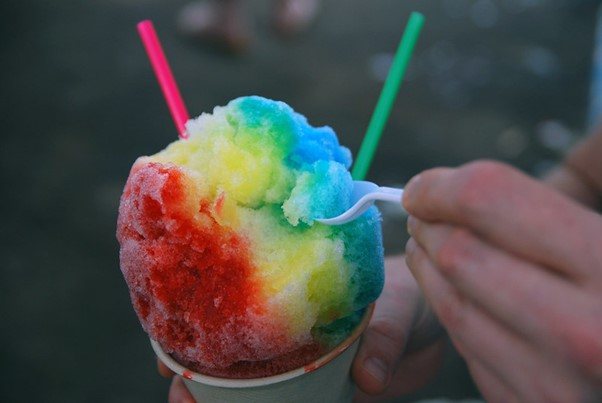
Harajuku Crepes
Crepes may not be distinctly Japanese, but they are distinctly Harajuku. It’s a longstanding tradition that anyone passing through the iconic neighbourhood should also enjoy one of the indulgent treats offered by vendors along Takeshita Street.
With dozens of flavour combinations to choose from, you’re sure to find one to tempt you. You can even get crepes topped with other desserts, like cheesecake or brownies. If you don’t have much of a sweet tooth, you can always opt for a savoury crepe instead.
The queues get pretty long, but the vendors are super-efficient, so they move quickly. Just make sure you have your order ready when you get to the front of the line, so you don’t hold it up.
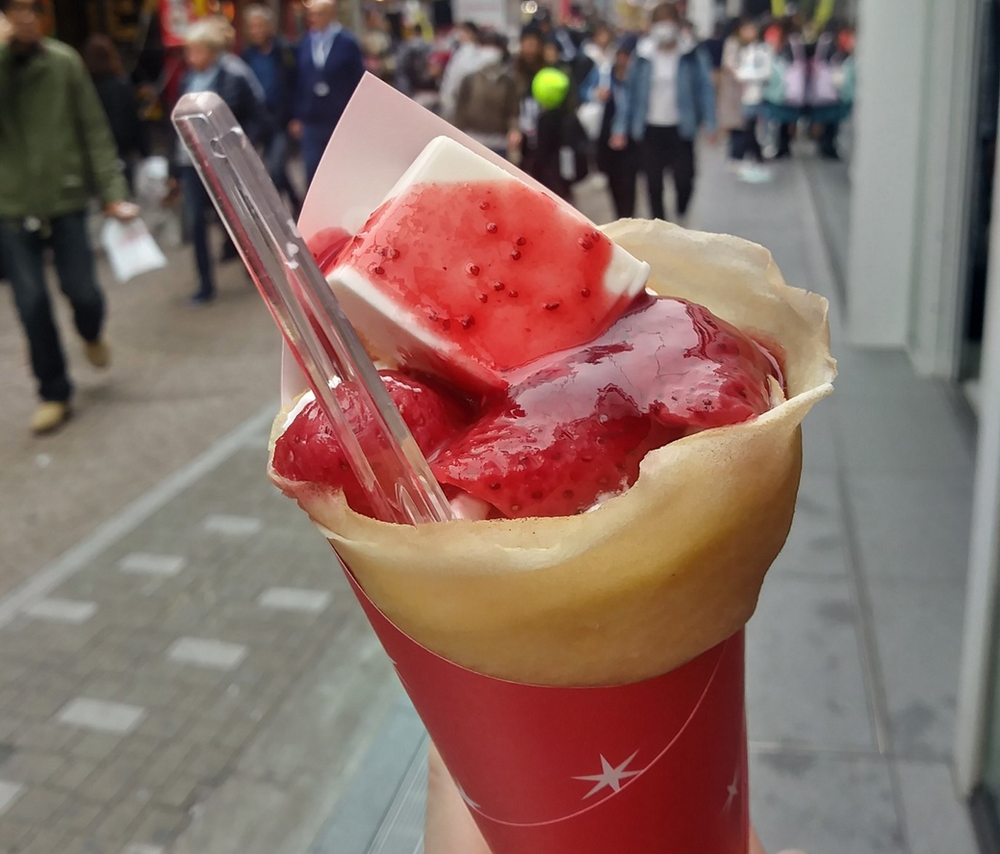
Chocobanana
Another staple of any festival or Tokyo street food market is the cheery chocobanana. Like it sounds, chocobanana consists of a banana, usually on a stick, coated in chocolate. It’s as simple as it is iconic.
Brightly coloured and covered in sprinkles, it makes the perfect treat for children. Of course, that’s not to suggest that mature adults can’t enjoy a chocobanana too. There’s no age limit on the joys of sprinkle-coated bananas on sticks.
Even fussier palates with little interest in all the strange new tastes and textures of Tokyo may be won over by the familiar flavours of chocolate and banana.
The simplicity of the chocobanana means that they rarely cost most than 200 yen or so, even near big attractions with inflated tourist prices. This makes them ideal if you just want a quick snack that’s light on the wallet as well as the stomach.
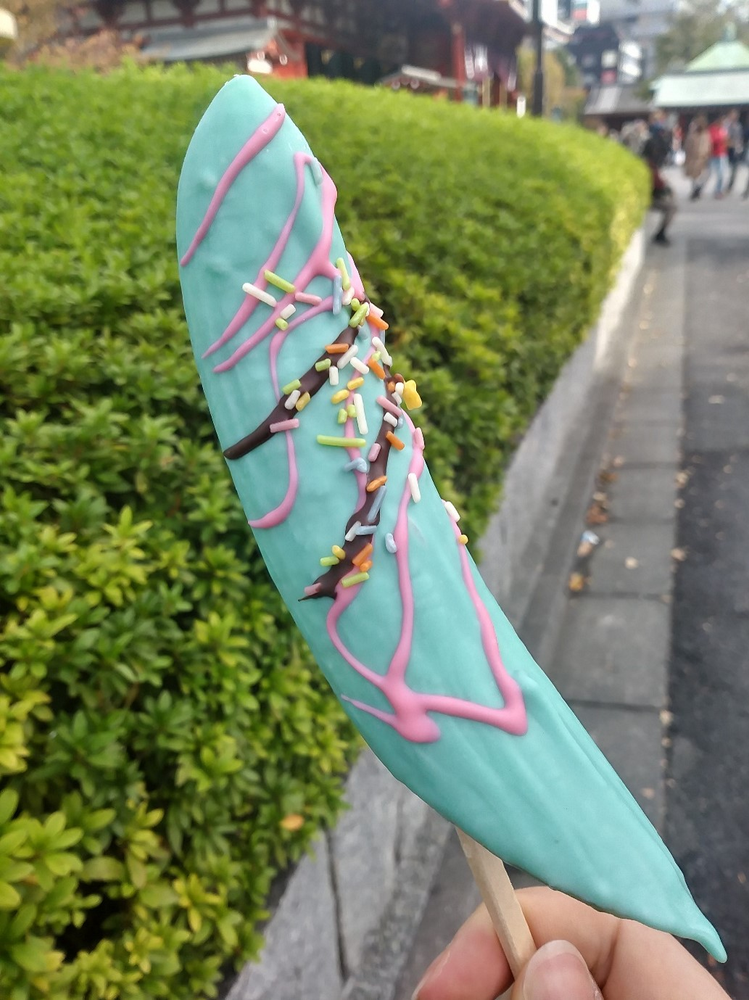
Honourable Mentions
These next couple of recommendations stretch the definition of Tokyo street food a little. However, if you define it simply as ‘food to eat on the street’ then they fit. Especially as both are big parts of Japan’s unique culture.
Convenience Store Fried Chicken
If you are jetting around the streets of Tokyo and looking for somewhere to grab a quick bite on the go, you can always count on any of the many convenience stores, or ‘conbinis’, peppering the city.
Although some of the brands, 7-Eleven in particular, may sound familiar, Japanese conbinis take the concept of convenience seriously.
Selling everything from fresh baked goods like melonpan and lunch staples like onigiri, to seasonal beverages, such as chestnut milk and sakura lattes, convenience stores are a great place to pick up a variety of japanese treats.
The excitement then continues at the hot food counter.
Japanese convenience store fried chicken has somewhat of a cult following. Fans argue over which convenience store does it best, with each offering their own styles and flavourings. The only way to decide is to try each for yourself.

Vending Machines
With 1 vending machine for every 23 people in a country with a population of 126 million, Japan has the most vending machines per capita in the world. It’s no wonder then, that you can expect to find more in them than just soda and chocolate bars.
No matter where you are in Tokyo, you are rarely more than a minute or so away from a vending machine. The most common vending machines are indeed stocked with drinks, so you can easily pick up a cold bottle of ramune or a can of hot coffee.
If you’re hungry, vending machines offering cans of hot soup, curry, and local snacks are fairly common.
If you know where to look, you can even find machines that sell hot meals, like burgers, chicken nuggets, and even ramen. It’s not exactly restaurant quality, but it is a unique experience.
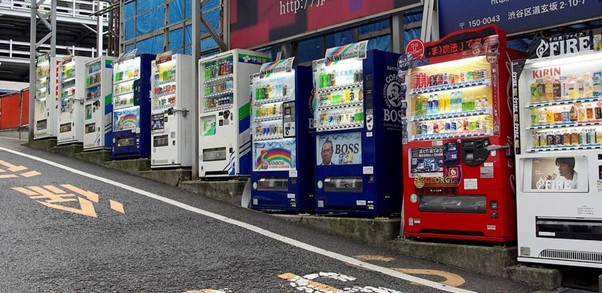
Final Thoughts
So those are my top ten suggestions for the Tokyo street food to look out for around the city during your visit. Some are entrenched in history and culture, while others are more modern treats. However, they all provide an introduction to the unique flavour of Japan.
There is plenty more for you to discover in and around the city too.
From popular food markets and world-class restaurants to trendy pop-up cafes, Tokyo is a playground for foodies. These ten items are a great starting point for your culinary adventure around Japan’s capital and cuisine. Now all that's left is to work out where to stay in Tokyo so you can experience it all for yourself.
